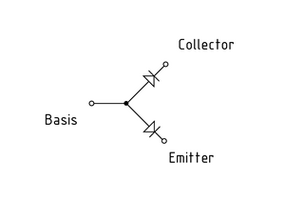
Choose one
or multiple languages
0,1,1
- German
- English
- Chinese
- Spanish
Transistor

Transistors are electronic amplifying components and have a three-layered structure - either pnp or npn. They can be used as amplifiers or switches. The equivalent circuit comprises two diodes connected in opposite directions and with different Doping and the base connected to the common cathode (or anode).
The base-emitter (BE) Diode is relatively strongly doped and the base layer is kept very thin (approx. 10 µm). The base current flowing through the highly doped BE diode controls the emitter current. This current diffuses almost completely through the thin base layer to the collector, which means the collector current on the output side${I_C}$ is many times higher than the controlling current${I_B}$. The base current${I_B}$ to collector current ratio is also called the current amplification factor.
The way transistors Work explains the equivalent circuits of other semi-Conductor components such as thyristors, IGBTs and MOSFETs.
